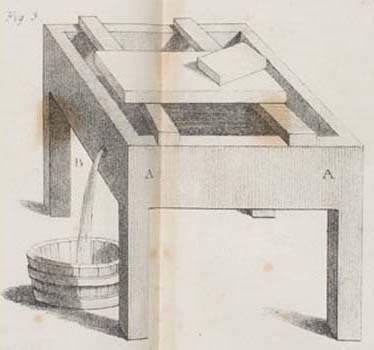“Table to Prep Stones for Chalk Drawings.” Detail from plate published in Antoine Raucourt, A Manual of Lithography (London:Longman, Rees, Orme, Brown, Green and Longman,1832). Courtesy of the Historical Society of Pennsylvania.
Between 1830 and 1870, the cost of large stones held steady at 10-12 cents a pound. Similarly, the process of preparing them and their smaller counterparts was little changed. First, a slurry of moistened fine grain sand was applied to the stone’s surface. Then, another, slightly smaller stone was placed on top and moved in a circular motion, while the sand and water run-off flowed through a valve as illustrated. Late in the century, a device known as a levigator could be used for graining and polishing. An advertisement from Printers’ Circular for a steam-powered model is on display.
Click image for larger view.
